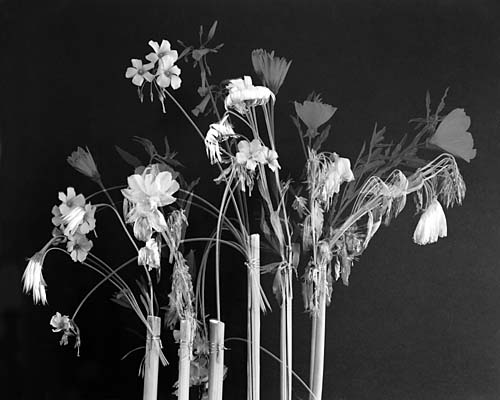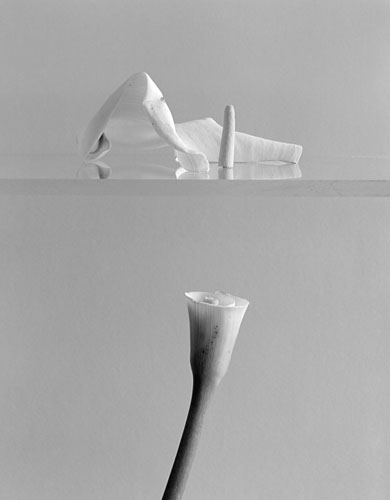Here’s another recently completed image in my Destructive Testing series, “Comparative Wilt Test.”

James SOE NYUN: Comparative Wilt Test: Oenothera, Osteospermum, Oxalis. Digital pigment print, 16 x 20 inches.
The original photos were taken in the late 90s, and my original intention was to print them sequentially so that you could see the wilting in process. I tried that, but then decided it wasn’t interesting enough. Recently I decided to revisit some of the negatives using Photoshop. I ended up superimposing five of the original images and used different kinds and degrees of transparency for each layer. I like this result much better, though I could also see this turning into a stop-motion video at some point.
The image memorializes a pseudo-science experiment I conducted to see how three different flowering plants would behave when cut off the mother plant, lashed to some supports, then allowed to wilt over the course of several days. The victims in this case are three plants in the garden I was having some ill feelings towards: Mexican evening primrose (Oenothera speciosa), freeway daisy (Osteospermum fruticosum), and Bermuda buttercup (Oxalis pes-caprae).
My primrose problems went back to a packet of “wildflower seed” that I’d purchased as a souvenir at the Grand Canyon in the early 1990s. The picture on the packet was appealing: delicate pink flowers on a dainty plant. And they were wildflowers! At first I was thrilled that the sprinkling of seed I applied to some desolate ground in the front yard started to germinate. I was even happier when there was that first extravagant first flowering, with dozens to hundreds of the papery, soft pink flowers covering the plants so you couldn’t see the barren ground anymore.
Okay, if you know the plant, I can tell you’re laughing and know where this is headed… But as I soon found out, as pretty as it is, this is one aggressive plant, reseeding tenaciously and spreading quickly by putting out dense webs of underground runners. More than ten years later, I’m still pulling at the stems that continue to come up in that bed. And even though they’re wildflowers, they’re not native to San Diego. Fortunately for the local ecosystem, they haven’t escaped from the bed where I naively gave them the gift of life.
Plant number two, the freeway daisy, had similar issues. It started out life as a tiny plant in a four-inch pot but soon spread like a demon, swallowing up a number of little annuals that stood in its way. At least the plant didn’t reseed much, and the stems, though they can sometimes set down root, were easy enough to control.
The final plant, the Bermuda buttercup, is a common and obnoxious weed over much of coastal Southern California. During its peak bloom in the middle of spring the perky yellow flowers over the attractive clover-ish leaves are a nice sight. But once you have it, you’ll probably have it forever.

